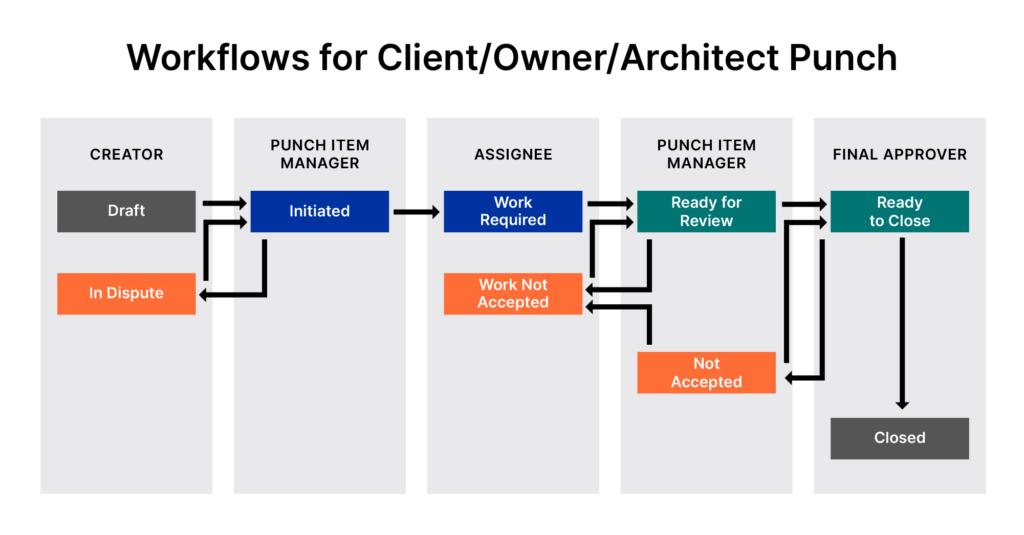— 14 min read
The Construction Closeout Process Explained
Last Updated Mar 20, 2024

After most work on a project is complete, but before a building fulfills its intended use, is one of the most important and complex parts of building: closeout. Closeout is the final phase of construction before a project is handed over to the owner. It’s a multi-step process that requires wrapping up every part of the job, from outstanding work to documentation to payment.
This article will explore all parts of closeout, including what to expect, how to prepare, and where they often go wrong.
Table of contents
The Basics of Construction Closeout
The stakes of closeout can feel high. Project owners want to move into their building, open it for business, or sell it. Contractors want to collect final payment and set themselves up for success on future projects. Just based on the sheer number of variables involved, closeout has the potential to be very stressful and to go longer or require more work than expected.
However, a well-managed closeout is possible and is one of the biggest factors determining if a project finishes on time and on budget — and how likely a client is to come back for repeat business.
Closeouts vary in how complicated they are, based on the project and its intended use. In general, the larger the project, the longer and more demanding wrapping it up will be. There are a few things that always improve the process.
Planning
One of the best ways to ensure closeout is as smooth as possible is to start planning for it as soon as the project begins. Contractors who wait to begin thinking about closeout until the last few months of construction usually find themselves trying to complete an impossibly large number of tasks in an impossibly small amount of time.
Many requirements for closeout — such as warranties or documents for obtaining a certificate of occupancy — are easier to collect while work is ongoing. For example, a general contractor must collect a number of documents from each subcontractor, such as manuals, warranties, or lien waivers. A general contractor who has planned ahead will be able to collect these items while the subcontractor is still on the job, as opposed to tracking them down months later when they’ve moved on to other projects.
Organization
Planning ahead only works if a general contractor has an organization system that ensures documentation collected throughout construction is thorough and accessible. Closeout becomes much more manageable when it's clear what documents have already been collected and where they are. A great example is change orders, which can happen many times on each project and can alter the project’s scope, schedule, and payment. Tracking change orders as they are submitted and completed helps many parts of closeout, including keeping as-is drawings up to date, making document submission easier, and helping people get paid sooner.
Communication
Closeout requires an immense amount of problem-solving, negotiation, and coordination. Fostering effective communication makes the process easier to navigate and helps avoid stressful situations turning into heated interactions.
Subcontractors should understand the required documentation before saying work is complete, and have an idea of a project’s timeline, so they know where they fit in and when they will likely get paid.
Owners should understand what to expect, when to expect it, and someone should update them on delays to help maintain positive relationships that can turn into repeat business.
On budget, on schedule, and in control.
Build with less risk and bigger profits.

What Happens When Closeout Goes Poorly
Snags, delays, and headaches happen. However, the longer closeout goes, the more resources are lost. For owners, prolonged closeout can result in losing money, as they pay for additional work while not have access to using or selling their building.
For contractors, an unexpectedly long closeout can drain their capacity to work on anything else. Final payments are also often connected to completing closeout. In worst-case scenarios, contractors who cause closeouts to go long can be responsible for paying liquidated damages.
Eight Steps to a Successful Project Closeout
The closeout process involves several steps. Below are eight activities generally required to close out a project.
1. Substantial completion
Substantial completion is the point in construction when the owner and contractor agree a building is ready for its intended use, even if minor work still needs to be done. Many projects, especially those using contract documents from the American Institute of Architects (AIA), require a certificate of substantial completion.
While owners and contractors might agree the building is ready, they don’t have the authority to determine whether a building is up to code and safe. That’s up to the local building authority which issues certificates of occupancy.
Determining what counts as being “substantially complete” can be complex, and is very project-specific. The contractor and the owner or owner’s representative will usually conduct a walk-through together where they compile a list of items that still need to be done, aren’t working as expected, or deviate from approved building plans. These items make up the punch list.
2. Completion of Punch List Items
The punch list consists mostly of incomplete or deficient items found on the substantial completion walkthrough. Generally, these are important issues that might be needed to obtain a certificate of occupancy, meet local building codes, or adhere to building plans, but are manageable enough that they shouldn’t keep closeout from continuing.
Determining what is included on the punch list and when items have been addressed can be challenging. The general contractor usually assigns an item to the subcontractor responsible for that area of work. When the item is completed, it’s submitted back to the owner or, depending on the work, the design team. A punch item is closed when the owner, or whoever created the item, acknowledges it’s been satisfactorily addressed.

If a contractor disagrees with a punch item, they can usually dispute it. The question in this situation is whether the component meets the original approved building plans, as opposed to an owner not liking how something turned out. Resolution might include consulting the drawings, the contract, or running it by the design team or architect.
It’s common for a project to have hundreds or even thousands of punch items, which can make the punch list the most difficult part of closeout. Large commercial buildings with many stories can easily have tens of thousands of punch items. We recommend checking out this webinar from Procore staff and experienced contractors to learn more about the challenges of the punch list and how to navigate them.
3. Submission of Closeout Documents
Owners need all documents required to successfully manage and maintain the building. This includes drawings that reflect final construction details, operation and maintenance manuals, warranties, product data, and final affidavits. We will share details on each of these in the documents section below.
The general contractor should deliver these resources in a way that is easy to navigate and search. Owners who struggle to find information often reach back out to the contractor, so clear systems of organization can save time for everyone.
These materials used to be printed out and delivered in a bunch of three-ring binders. These days, materials are commonly delivered digitally, which is easier to store and to search. However, these virtual binders should still be very organized, with clear naming conventions and well-organized folders.
4. Final Inspection
The final inspection assesses the safety of buildings by checking for compliance with local building codes and laws, and ensuring that any issues from previous inspections have been resolved. Final inspections are done by a licensed inspector from the local building authority and are usually a requirement to obtain a certificate of occupancy. Many cities, such as Austin, TX, or Tampa, FL, provide final inspection checklists on their websites.
5. Training
Some equipment and systems installed during construction need training to operate and maintain, particularly things that will be regularly used during the life of the building. Contractors or vendors are often required to train the owner’s team before the handoff is complete. This is even included in some contracts. A common training in many commercial buildings is for the air handler unit, which might include instruction on how to restart the system or change an air filter.
Training is usually done in person and is often explicitly scheduled into a project’s timeline. Documenting that a training occurred is often done by including a paper with key takeaways as part of the closeout documents or including a video of the training itself. These serve the dual purpose of demonstrating a contractor fulfilled their responsibilities while also creating a reference that can be reviewed and shared in the future.
6. Final Payments and Release of Retainage
Many contracts define the deadline for final payments to a contractor as a project being “substantially complete.” Some contracts allow for a retainage, which is a percentage (usually between 5% and 10%) of a contract's value that is withheld from a contractor until the end of the job.
On projects using contracts from the AIA, this deadline is commonly defined as when a building has received a certificate of substantial completion and a certificate of occupancy. This deadline has a cascading impact, as it’s common for general contractors to pay a subcontractor once they have received payment from the owner.
Closeout is also the time to settle all outstanding bills, change orders, or any other additional costs. Contractors will usually submit a lien waiver to verify a payment has been received.
7. Transfer of Utilities and Facilities
The contractor often manages utilities during construction and transfers them to the owner once work is complete. Projects under construction often receive temporary electricity, which is changed to permanent power when the building is substantially complete and the owner takes over. Similar processes may be required for water, internet, or gas.
The transfer process can often take longer than the contractor and owner want, as it involves utility companies with no investment in the construction timeline and are beholden to their own internal processes. It is best to contact these companies early to know what to plan for, as some places have very specific requirements. For example, Dallas requires an inspection by and approval from building, electrical, and plumbing/mechanical inspections before permanent electricity can be turned on.
8. Acquisition of Certificate of Occupancy
A certificate of occupancy is a legal document that certifies a building is safe and ready to be used, by verifying the structure complies with local building codes, usage regulations, and safety requirements. It is usually required anytime a property is newly constructed, has been converted to a different usage classification, has had major renovations, or is changing ownership.
To ensure a building is done and safe for use, a local building authority will ensure all permits are closed and conduct any necessary inspections to check if a structure meets relevant code and laws.
Build Predictability and Productivity
Deliver projects on time and on budget with greater visibility.

Key Documents Needed During Closeout
During closeout, contractors and suppliers will need to provide a variety of documents to the owner based on the building, location and intended use. Many key documents listed below, such as data sheets, manuals, or as-built drawings, are required to go through a submittal process. Including proof of submittals is often required during closeout.
- As-built drawings
- Warranties
- Final lien waivers
- Final change orders
- Operation and maintenance manuals
- Data sheets
- Reports
Responsibilities During Closeout
Closeout represents the culmination of the construction process, so it often requires input from many people involved in the build.
General Contractor
The general contractor oversees the process:
- Ensuring completed work aligns with building plans
- Resolving outstanding change orders
- Submitting necessary documentation for final review
The general contractor also submits all information regarding payment to the client, including retainage, unpaid expenses, and final change orders. Once the general contractor receives payment, paying out the subcontractors is often their job next.
On projects with a construction manager, the CM may handle this responsibility.
Owner
The owner, or a representative for the owner, is responsible for acknowledging that the finished product reflects the approved plans and changes and for ensuring they have everything they need to begin using or selling the building. This can include reviewing and approving all completed work, taking over the operation and maintenance of the facility, and making final payments.
Architect/Design Team
The design team’s work is often complete long before closeout rolls around. However, design teams are sometimes called upon to approve that completed punch items reflect building plans.
Subcontractors
Subcontractors might be asked to complete punch items if the issue has to do with their scope of work. During or before closeout, subcontractors should provide all necessary warranties, manuals, and maintenance instructions. Depending on the work they did, they might also be responsible for conducting training.
Some subcontractors finish their work early in the construction process, such as someone who did earthwork excavation or someone who put up steel for the building. In these cases, the general contractor should try to collect all required documentation while the subcontractor is still on the job or shortly after they finish.
Suppliers/Vendors
The most pressing thing needed from suppliers and vendors during closeout is any warranties or manuals that haven’t been collected, though most of these things are usually provided when their product is installed.
After Closeout
After closeout, contractors are still involved in the process. They may conduct a project debrief, store project documents, and track warranty deadlines.
Project Debrief
The project debrief is a meeting that gathers together project stakeholders to discuss and reflect on what went well and what can be improved in the future. General contractors often use these meetings to gain an understanding of how their system of organization fared, how their team performed, or the performance of people with which they partnered.
Debriefs are more purposeful when they include as many important people from the build as possible, such as the design team, subcontractors, or the owner. Since coordinating schedules is always difficult, project debriefs can include surveys from the client or subcontractors.
Contractors sometimes opt to skip project debriefs, considering them too time consuming or believing that most takeaways are project specific. It can also feel stressful to reflect on the last job when the next one already requires attention. However, a well-executed project debrief is often a chance for stakeholders to feel heard and valued, and can be part of getting repeat business and maintaining a healthy network of subcontractors.
Project Document Archival
Both owners and contractors should store all project-related documents for future reference, especially those related to potential warranty claims or modifications. Documents should be accessible and searchable, as they include necessary information for an owner to operate and maintain their building and for a contractor to quickly answer client questions or concerns.
Warranty Work
Workmanship warranties often begin after a building is deemed substantially complete and usually extend for about a year. During this time, contractors are expected to address defects or issues related to their work. Depending on the product, equipment and systems, warranties usually take effect from the date of installation and last for many years.
Some issues require the owner to call on both warranties. For example, a failed window seal might allow moisture to collect between the double panes. The manufacturer would likely provide a new window — and if it’s within the workmanship warranty period, the contractor that installed the window would return to the site, take out the old window, and install the new one.
Closeout Is What People Remember
Closeout is a lot like the ending of the movie: If it’s done poorly, people are likely to forget any good that came before it.
Closeout is demanding and, very often, stressful, but it is also a chance to build relationships and demonstrate habits that can create repeat business. Beginning to prepare from the beginning of the job can make closeout less about scrambling to track things down and organize them, and more about presenting and verifying the great work that was done.
Categories:
Tags:
Written by
Dave Brown
Dave is a Senior Strategic Product Consultant for Procore, specializing in General Contractors. Previously, he worked for Consigli Construction Co in Boston and Washington, DC as a Project Engineer and Assistant Project Manager, responsible for a variety of activities including bidding and procurement, contracts, and cost control. Dave holds a Bachelor's Degree in Structural Civil Engineering from Bucknell University.
View profileJames Hamilton
29 articles
James Hamilton is a writer based in Brooklyn, New York with experience in television, documentaries, journalism, comedy, and podcasts. His work has been featured on VICE TV and on The Moth. James was a writer and narrator for the show, VICE News Tonight, where he won an Emmy Award and was nominated for a Peabody Award.
View profileReviewed by
Ernest Garcia
Ernest Garcia is a Solutions Engineer at Procore. Prior to joining the construction tech industry, Ernest worked as a project manager and superintendent, overseeing large-scale healthcare and government construction projects across the U.S. He's successfully completed projects for the United States Air Force, Department of Energy, Army Corps of Engineers, Los Alamos National Laboratories, and Border Patrol. Outside of work, he enjoys all things outdoors, metal fabrication and woodworking, and spending time with his family and dogs. He lives in Glendale, AZ.
View profileWin More Work
Get discovered for relevant work on the Procore Construction Network.

Explore more helpful resources

Construction Drawings: Picturing Project Success
Every construction project — whether it be a kitchen renovation or a new highway overpass — relies on a set of comprehensive drawings to communicate what should be constructed. For...

Construction Teamwork: Build a Solid Foundation With the Right Team
Construction is an industry of collaboration — no one person completes any job on their own. It could easily be argued that the most important skill for anyone in this...

Contract Precedence: A Clause to Clear Construction Confusion
Construction contracts are usually lengthy and complicated, composed of a wide range of documents In a perfect world, the contract provides the clarity and direction all stakeholders need to move...

A Contractor’s Guide to Working With Construction Union Labor
In the construction industry, unions play a critical role, bringing together laborers and tradespeople such as plumbers, carpenters or masons under collective bargaining agreements with employers. These agreements set the...
